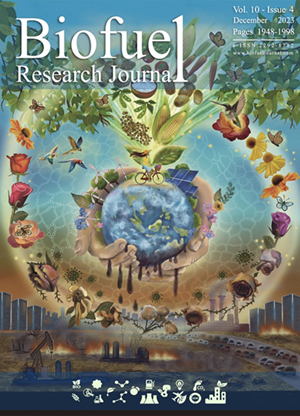生物质热解生产生物燃料的催化剂综述
IF 14.4
Q1 ENERGY & FUELS
引用次数: 51
摘要
近年来,生物质原位催化热解技术得到了广泛的研究,以获得具有成本竞争力的高品质生物油。为了实现这一目标,人们研究了许多催化剂,通过转化含氧化合物和大分子物质来促进低品位可冷凝蒸汽(生物油)的原位升级。本文对这些催化剂进行了分类,并结合实验装置的规模,系统评价了催化剂对热解产物的影响及其特性。在这些催化剂中,微孔沸石被认为是最有前途的催化剂,具有定制所需生物油性质的潜力。更具体地说,沸石的突出优点是高效脱氧和降低所得生物油的分子量,而主要缺点是生物油的有机相收率降低和焦炭沉积导致催化剂失活。除沸石基催化剂外,还对介孔硅铝酸盐等催化剂进行了综述和讨论。介孔硅铝酸盐是一类广泛应用于生物油和碱性化合物脱氧的催化剂。对后者的研究还不是很广泛,但初步结果已经揭示了它们在生物油脱氧、碳氢化合物生产和减少不需要的化合物方面的潜力。然而,这些催化剂需要进一步系统地研究。总的来说,进一步开发用于生物油选择性脱氧和裂解的专用催化剂对于扩大现有热解技术的规模,通过热解实现生物燃料的商业化生产至关重要。本文章由计算机程序翻译,如有差异,请以英文原文为准。
An overview of catalysts in biomass pyrolysis for production of biofuels
In-situ catalytic pyrolysis of biomass has been extensively studied in recent years for cost-competitive production of high quality bio-oil. To achieve that, numerous catalysts have been studied to facilitate in-situ upgrading of low-grade condensable vapors (bio-oil) by converting oxygenated compounds and large-molecule species. In this review, these catalysts are categorized in different families and a systematic evaluation of the catalyst effects on pyrolysis products and their characteristics is carried out with respect to the scale of the experimental setup. Among these catalysts, microporous zeolites are considered as most promising in terms of performance and the potential to tailor the desired bio-oil properties. More specifically, the prominent advantages of zeolites include efficient deoxygenation and molecular weight reduction of the resultant bio-oil, while the main drawbacks are decreases in the yield of bio-oil’s organic phase and catalyst deactivation by coke deposition. In addition to the zeolite-based catalysts, other catalysts including mesoporous aluminosilicates, a widely-applied class of catalysts used for deoxygenation of bio-oil as well as alkaline compounds are also reviewed and discussed herein. The research on the latter has not been extensive but the preliminary results have revealed their potential for deoxygenation of bio-oil, production of hydrocarbons, and reduction of undesired compounds. Nevertheless, these catalysts need to be further investigated systematically. Overall, further development of dedicated catalysts for selective deoxygenation and cracking of bio-oil would be essential for scaling up the existing pyrolysis technologies to achieve commercial production of biofuels through pyrolysis.
求助全文
通过发布文献求助,成功后即可免费获取论文全文。
去求助
来源期刊

Biofuel Research Journal-BRJ
ENERGY & FUELS-
CiteScore
22.10
自引率
1.50%
发文量
15
审稿时长
8 weeks
期刊介绍:
Biofuel Research Journal (BRJ) is a leading, peer-reviewed academic journal that focuses on high-quality research in the field of biofuels, bioproducts, and biomass-derived materials and technologies. The journal's primary goal is to contribute to the advancement of knowledge and understanding in the areas of sustainable energy solutions, environmental protection, and the circular economy. BRJ accepts various types of articles, including original research papers, review papers, case studies, short communications, and hypotheses. The specific areas covered by the journal include Biofuels and Bioproducts, Biomass Valorization, Biomass-Derived Materials for Energy and Storage Systems, Techno-Economic and Environmental Assessments, Climate Change and Sustainability, and Biofuels and Bioproducts in Circular Economy, among others. BRJ actively encourages interdisciplinary collaborations among researchers, engineers, scientists, policymakers, and industry experts to facilitate the adoption of sustainable energy solutions and promote a greener future. The journal maintains rigorous standards of peer review and editorial integrity to ensure that only impactful and high-quality research is published. Currently, BRJ is indexed by several prominent databases such as Web of Science, CAS Databases, Directory of Open Access Journals, Scimago Journal Rank, Scopus, Google Scholar, Elektronische Zeitschriftenbibliothek EZB, et al.
 求助内容:
求助内容: 应助结果提醒方式:
应助结果提醒方式:


